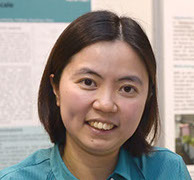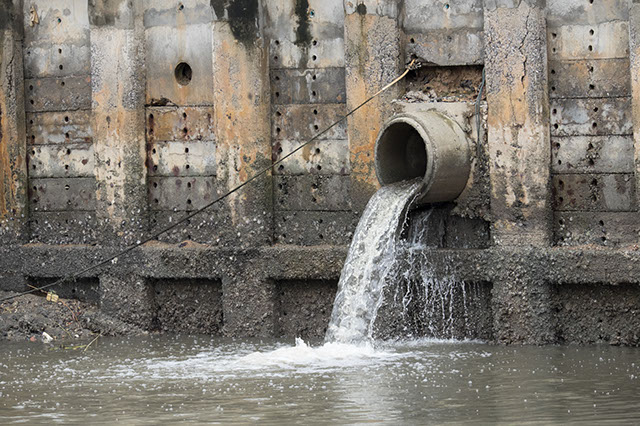Before the days of concrete drainage systems, rainwater would infiltrate deep into the ground, be cleansed by soil as it filtered through the earth and gradually be dispersed back into streams, rivers and eventually the sea. Concrete and non-porous roads and pavements changed all that. Now storm water gushes down concrete gulleys, sometimes causing flooding, before cascading straight back into the sea.
Dr May Chui, Assistant Professor in the Department of Civil Engineering, is seeking ways to return to more natural, more sustainable and more useful ways to deal with storm water. She recently completed a feasibility study on introducing Sustainable Drainage Systems (SuDS) into Hong Kong.
“The problem at the moment is our drainage systems focus mainly on controlling floodwater, but not on environmental issues,” she said. “We mostly use concrete drains, which are not sustainable and hold water in buried storage tanks which are not good for the environment.”
“Ground water is naturally quite clean, as soil itself can be a natural filter, so with SuDS water is absorbed into the ground, naturally treated, then slowly dispersed into rivers and canals, and eventually the sea. This slow dispersal also reduces the risk of flooding during peak flows into the drainage system. In addition, the quality of the water going back into the environment is better.
“One of the major advantages of SuDS is that they work with nature rather than against it.”
Other advantages include aesthetics. One of the easiest methods of introducing SuDS involves building flowerbeds over current drainage troughs, with a side drainage entrance, another involves decking an open nullah with a green channel cover. Both use current facilities, but look nicer and are better for the environment.
Challenges in Hong Kong include the limited space in our crowded city, high annual rainfall and public perception – in short, people may not want to pay the extra money it will take to convert to SuDS. However, Dr Chui was pleased to find that in a survey of 600 people told about sustainable drainage, around 90 per cent of those interviewed said they would support its implementation, with most citing reducing the greenhouse effect and environmental enhancement as their main reasons.
Similar systems have already been introduced in Singapore – where Dr Chui began her work in this area – as well as in the US, where these systems come under the heading of low impact development, and China, where new urban developments using SuDS are simply called ‘sponge cities’.
The feasibility study covers the costs involved, the survey about people’s perception of the concept in Hong Kong, as well as how SuDS work and the benefits these systems would bring.

![]() One of the major advantages of Sustainable Drainage Systems is that they work with nature rather than against it.
One of the major advantages of Sustainable Drainage Systems is that they work with nature rather than against it. ![]()
Dr May Chui
Multiple benefits
According to Dr Chui, those benefits are environmental, economic and social. “From the environmental viewpoint, SuDS improve water quality, introduce more plants which are good for human health, and can protect or restore wildlife habitats,” she said. “Economically, they can reduce energy consumption and costs, and they even increase land and property values simply because they are more aesthetically pleasing.
“And socially, the introduction of SuDS could create more attractive street-scapes and rooftops which will enhance urban green spaces, and will help ventilate the city landscape thereby mitigating against urban heat problems.”
Dr Chui’s feasibility study has been partly funded by the Central Policy Unit and she is working closely with some government departments on getting SuDS up and running in Hong Kong. “This crosses the remit of several government departments, such as the Drainage Services Department, the Civil Engineering and Development Department, the Highways Department and the Leisure and Cultural Services Department,” she explained.
“If it is to be implemented in Hong Kong we need large-scale planning. The Government would probably have to come up with incentives for private developers to utilise SuDS rather than just focussing on their own facilities.”
The bioretention systems required can reasonably easily be built over current drainage systems and under existing green areas – such as planted roundabouts and plant beds currently used as central dividers on major roads. Green roofs are another perfect location for them, and the gradual introduction of porous pavements– rather than non-porous concrete – could be done gradually over time as and when existing pavements require repair.
“The way forward now is to identify areas for SuDS implementation, from individual field trials to large-scale implementation in urban developments, and to promote SuDS to the public and educate them about its benefits.”
Conventional, non-sustainable, concreted-lined drain.
Potential application of Sustainable Drainage Systems in Hong Kong, converting existing plant beds to bioretention systems.
Large scale planning of Sustainable Drainage Systems.

Nature’s Answer To The Rain Drain
Feasibility study reveals the advantages of introducing environmentally-friendly and sustainable drainage systems for stormwater.



Next
Back


